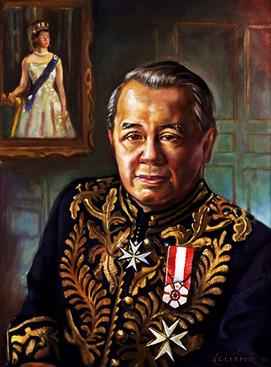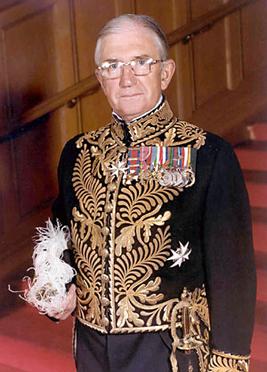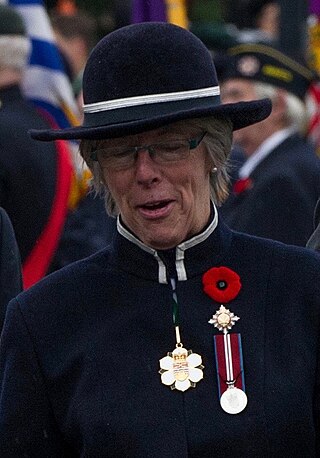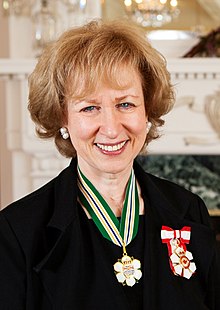
The coat of arms of British Columbia is the heraldic symbol representing the Canadian province of British Columbia. The arms contains symbols reflecting British Columbia's British heritage along with local symbols. At the upper part of the shield is the Union Jack, representing the United Kingdom. The lower portion of the shield features a golden sun setting into the ocean, representing the province's location on the Pacific.

Iona Victoria Campagnolo is a Canadian politician who served as the 27th Lieutenant Governor of British Columbia from 2001 to 2007; Campagnolo was the first woman to hold that office. Prior to becoming Lieutenant Governor, she was a Cabinet member in the Liberal government of Prime Minister Pierre Trudeau.

David See-chai Lam, was a Hong Kong-born Canadian banker, businessman, investor, philanthropist, and politician. From 1988 to 1995, Lam was the 25th Lieutenant Governor of British Columbia, and he was the first Chinese Canadian to be appointed as a vice-regal in Canada. He was known for his charitable efforts, donating millions of dollars and leveraging millions more to support educational institutions and activities in Hong Kong, Canada, and the United States.

The National Order of Quebec, termed officially in French as l'Ordre national du Québec, and in English abbreviation as the Order of Quebec, is an order of merit in the Canadian province of Quebec. Instituted in 1984 when Lieutenant Governor Jean-Pierre Côté granted royal assent to the Loi sur l'Ordre national du Québec, the order is administered by the Governor-in-Council and is intended to honour current or former Quebec residents for conspicuous achievements in any field, being thus described as the highest honour in Quebec. In 1986, the order was expanded to include honorary membership for people outside Quebec.
The Alberta Order of Excellence is a civilian honour for merit in the Canadian province of Alberta. Instituted in 1979 when Lieutenant Governor Frank C. Lynch-Staunton granted royal assent to the Alberta Order of Excellence Act, the order is administered by the Governor-in-Council and is intended to honour current or former Alberta residents for conspicuous achievements in any field, being thus described as the highest honour amongst all others conferred by the Canadian Crown in right of Alberta.

Henry Pybus "Budge" Bell-Irving, was the 23rd Lieutenant Governor of British Columbia from 1978 to 1983.
The Saskatchewan Order of Merit is a civilian honour for merit in the Canadian province of Saskatchewan. Instituted in 1985 by Lieutenant Governor Frederick Johnson, on the advice of the Cabinet under Premier Grant Devine, the order is administered by the Governor-in-Council and is intended to honour current or former Saskatchewan residents for conspicuous achievements in any field, being thus described in law as the highest honour amongst all others conferred by the Saskatchewan Crown.
The Order of New Brunswick is a civilian honour for merit in the Canadian province of New Brunswick. Instituted in 2000 by Lieutenant Governor Marilyn Trenholme Counsell, on the advice of the Cabinet under Premier Bernard Lord, the order is administered by the Governor-in-Council and is intended to honour current or former New Brunswick residents for conspicuous achievements in any field, being thus described as the highest honour amongst all others conferred by the New Brunswick Crown.
The Order of Newfoundland and Labrador is a civilian honour for merit in the Canadian province of Newfoundland and Labrador. Instituted in 2001, when Lieutenant Governor Arthur Maxwell House granted Royal Assent to the Order of Newfoundland and Labrador Act, the order is administered by the Governor-in-Council and is intended to honour current or former Newfoundland and Labrador residents for conspicuous achievements in any field, being thus described as the highest honour amongst all others conferred by the Newfoundland and Labrador Crown.

The Order of Nova Scotia is a civilian honour for merit in the Canadian province of Nova Scotia. Instituted on August 2, 2001, when Lieutenant Governor Myra Freeman granted Royal Assent to the Order of Nova Scotia Act, the order is administered by the Governor-in-Council and is intended to honour current or former Nova Scotia residents for conspicuous achievements in any field, being thus described as the highest honour amongst all others conferred by the Nova Scotia Crown.
The orders, decorations, and medals of the Canadian provinces, in which each province of Canada has devised a system of orders and other awards to honour residents for actions or deeds that benefit their local community or province, are in turn subsumed within the Canadian honours system. Each province sets its own rules and criteria for eligibility and also for how each award is presented. Most of the awards allow for the recipients to wear their awards in public, and most grant the recipients the use of post-nominal letters after their names. Not all of the awards listed below are part of the Canadian honours system, thus some of them may not be worn or court mounted with awards that are part of the Canadian honours system.

By the arrangements of the Canadian federation, Canada's monarchy operates in British Columbia as the core of the province's Westminster-style parliamentary democracy. As such, the Crown within British Columbia's jurisdiction is referred to as the Crown in Right of British Columbia, His Majesty in Right of British Columbia, or the King in Right of British Columbia. The Constitution Act, 1867, however, leaves many royal duties in British Columbia specifically assigned to the sovereign's viceroy, the Lieutenant Governor of British Columbia, whose direct participation in governance is limited by the conventional stipulations of constitutional monarchy.

The monarchy of Canada forms the core of each Canadian provincial jurisdiction's Westminster-style parliamentary democracy, being the foundation of the executive, legislative, and judicial branches of government in each province. The monarchy has been headed since September 8, 2022 by King Charles III who as sovereign is shared equally with both the Commonwealth realms and the Canadian federal entity. He, his consort, and other members of the Canadian royal family undertake various public and private functions across the country. He is the only member of the royal family with any constitutional role.
The British Columbia order of precedence is a nominal and symbolic hierarchy of important positions within the province of British Columbia. It has no legal standing but is used to dictate ceremonial protocol at events of a provincial nature.
- The King of Canada
- The Lieutenant Governor of British Columbia
- The Premier of British Columbia
- The Chief Justice of British Columbia
- Former Lieutenant Governors of British Columbia
- Hon. Iona Campagnolo PC OC OBC
- Hon. Steven Point OC OBC
- Hon. Judith Guichon OBC
- Former Premiers of British Columbia
- Bill Vander Zalm
- Rita Johnston
- Mike Harcourt OC
- Glen Clark
- Dan Miller
- Hon. Ujjal Dosanjh PC
- Gordon Campbell OC OBC
- Christy Clark
- John Horgan
- The Speaker of the Legislative Assembly of British Columbia
- The Members of the Executive Council of British Columbia by order of precedence
- The Leader of the Official Opposition of British Columbia
- Members of the King's Privy Council for Canada resident in British Columbia, with precedence given to members of the federal cabinet
- The Chief Justice of the Supreme Court of British Columbia
- Church representatives of faith communities
- The Justices of the Court of Appeal of British Columbia with precedence to be governed by the date of appointment
- The Puisne Justices of the Supreme Court of British Columbia with precedence to be governed by the date of appointment
- The Judges of the Supreme Court of British Columbia with precedence to be governed by the date of appointment
- The Members of the Legislative Assembly of British Columbia with precedence to be governed by the date of their first election to the legislature
- The Chief Judge of the Provincial Court of British Columbia
- The Commander Maritime Forces Pacific
- The Heads of Consular Posts with jurisdiction in British Columbia with precedence to be governed by Article 16 of the Vienna Convention on Consular Relations
- The Mayor of Victoria
- The Mayor of Vancouver
- The Chancellors of the University of British Columbia, the University of Victoria and Simon Fraser University, respectively.
- Hon. Steven PointOBC
- Marion Buller, CM
- Tamara Vrooman, OBC

Steven Lewis Point, (Xwelíqwetel) is a Canadian academic administrator, criminal lawyer, and jurist. He is the current chancellor of the University of British Columbia. He served as the 28th Lieutenant Governor of British Columbia from 2007 to 2012. He also served as the chair of the advisory committee on the safety and security of vulnerable women, a committee that provides community-based guidance to the implementation of the recommendations from the Missing Women Commission of Inquiry.
The Order of the Dogwood was the province of British Columbia's highest civilian honour for public service from 1966 to 1989, during which time 13 individuals were granted the honour of being appointed to the order.

James McEwen is a Canadian biomedical engineer and the inventor of the microprocessor-controlled automatic tourniquet system, which is now standard for 15,000-20,000 procedures daily in operating rooms worldwide. Their widespread adoption and use has significantly improved surgical safety, quality and economy. McEwen is President of Western Clinical Engineering Ltd., a biomedical engineering research and development company and he is a director of Delfi Medical Innovations Inc., a company he founded to commercialize some results of that research and development. He is also an adjunct professor in the School of Biomedical Engineering, in the Department of Orthopaedics and in the Department of Electrical and Computer Engineering at the University of British Columbia.

Judith Isabel Guichon,, is a Canadian rancher and organizer who served as the 29th Lieutenant Governor of British Columbia, serving from 2012 to 2018. She was the viceregal representative of Queen Elizabeth II in the province of British Columbia, and was appointed by Governor General David Johnston on the advice of then-Prime Minister Stephen Harper.

Janet Edna Merivale Austin is a Canadian former nonprofit sector executive and public servant who is the 30th lieutenant governor of British Columbia, having served since 2018. She is the viceregal representative of King Charles III in the province of British Columbia. Prior to her appointment as Lieutenant Governor, she spent 15 years as CEO of YWCA Metro Vancouver.
Gurdev Singh Gill was an Indian-born Canadian physician, community leader, and activist. He was recognized as Canada's first medical doctor of Indian origin. As a community advocate, he furthered many issues relevant to the Indo-Canadian community.














